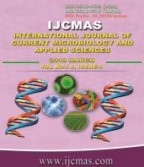


 National Academy of Agricultural Sciences (NAAS)
National Academy of Agricultural Sciences (NAAS)

|
PRINT ISSN : 2319-7692
Online ISSN : 2319-7706 Issues : 12 per year Publisher : Excellent Publishers Email : editorijcmas@gmail.com / submit@ijcmas.com Editor-in-chief: Dr.M.Prakash Index Copernicus ICV 2018: 95.39 NAAS RATING 2020: 5.38 |
The present investigation was conducted to study the effects of different housing systems on growth performance, feed consumption, morbidity and mortality of broiler rabbits in semi arid region of North Gujarat. Total 24 weaned rabbits (28 days age) were randomly divided in two housing treatments, T1 (Cage housing) and T2 (Deep litter housing system). The duration of experiment was 8 weeks. Dimensions of cage were 3×2×2 feet (3 rabbits/cage) whereas, in deep litter, 12 rabbits were kept in 24 square feet area (2 square feet/rabbit). Animals were fed restricted amount of concentrate and vegetables whereas green fodder was fed ad-lib. Weighted quantity of feed were given to rabbits and left over was collected next day early morning before offering fresh feed. Weekly observations were recorded for weekly body weight, weight gain and daily feed consumption data generated were analyzed for significant differences. Initial average body weight was 0.739±0.05Kg and 0.736±0.07Kg, respectively, in T1 and T2 groups. At the end of experimental period (12th week of age), there was no significant difference in the final body weight (2.619±0.09 kg v/s 2.500±0.10 kg) between T1 and T2 groups. Average weekly body weight gain was marginally high (but non-significant) in T1 (0.234±0.02 kg) than T2 (0.220±0.01 kg). There was no apparent morbidity and mortality in rabbits during the experimental period. The results indicate that weight gain were at par in the cage and deep litter system of housing. Further, maintaining well hygienic condition in deep litter system and changing the litter materials at the regular interval; gives the similar results as in cage system.
 |
 |
 |
 |
 |